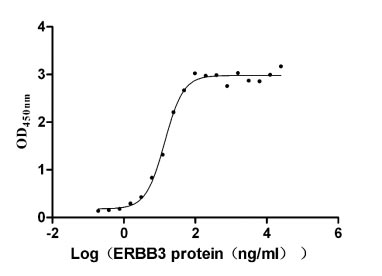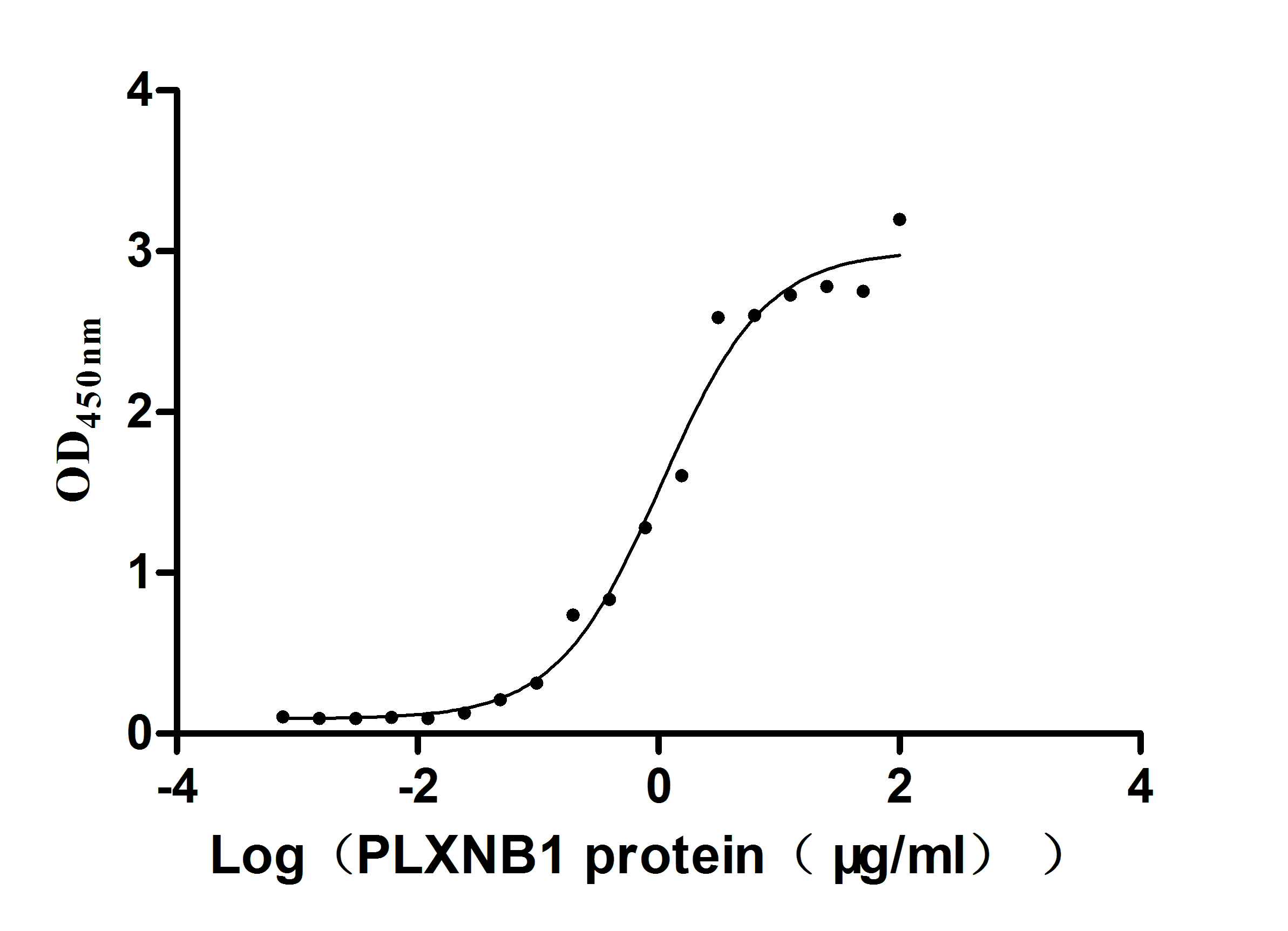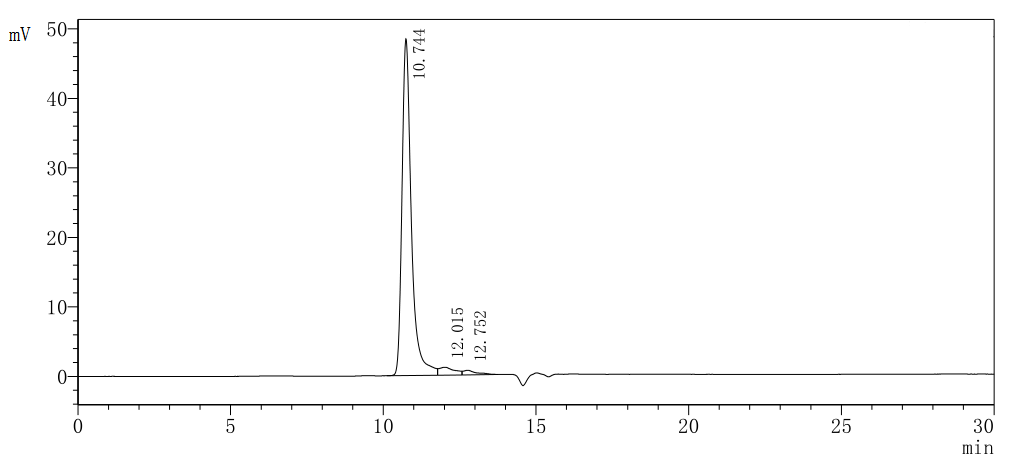Recombinant Human Cysteinyl leukotriene receptor 1 (CYSLTR1)
In Stock-
货号:CSB-CF006465HU
-
规格:¥9720
-
图片:
-
其他:
产品详情
-
纯度:Greater than 85% as determined by SDS-PAGE.
-
基因名:
-
Uniprot No.:
-
别名:CYSLTR1; CYSLT1; Cysteinyl leukotriene receptor 1; CysLTR1; Cysteinyl leukotriene D4 receptor; LTD4 receptor; G-protein coupled receptor HG55; HMTMF81
-
种属:Homo sapiens (Human)
-
蛋白长度:Full Length
-
来源:in vitro E.coli expression system
-
分子量:44.6 kDa
-
表达区域:1-337aa
-
氨基酸序列MDETGNLTVSSATCHDTIDDFRNQVYSTLYSMISVVGFFGNGFVLYVLIKTYHKKSAFQVYMINLAVADLLCVCTLPLRVVYYVHKGIWLFGDFLCRLSTYALYVNLYCSIFFMTAMSFFRCIAIVFPVQNINLVTQKKARFVCVGIWIFVILTSSPFLMAKPQKDEKNNTKCFEPPQDNQTKNHVLVLHYVSLFVGFIIPFVIIIVCYTMIILTLLKKSMKKNLSSHKKAIGMIMVVTAAFLVSFMPYHIQRTIHLHFLHNETKPCDSVLRMQKSVVITLSLAASNCCFDPLLYFFSGGNFRKRLSTFRKHSLSSVTYVPRKKASLPEKGEEICKV
Note: The complete sequence including tag sequence, target protein sequence and linker sequence could be provided upon request. -
蛋白标签:N-terminal 10xHis-tagged
-
产品提供形式:Liquid or Lyophilized powder
Note: We will preferentially ship the format that we have in stock, however, if you have any special requirement for the format, please remark your requirement when placing the order, we will prepare according to your demand. -
缓冲液:If the delivery form is liquid, the default storage buffer is Tris/PBS-based buffer, 5%-50% glycerol. If the delivery form is lyophilized powder, the buffer before lyophilization is Tris/PBS-based buffer, 6% Trehalose, pH 8.0.
-
复溶:We recommend that this vial be briefly centrifuged prior to opening to bring the contents to the bottom. Please reconstitute protein in deionized sterile water to a concentration of 0.1-1.0 mg/mL.We recommend to add 5-50% of glycerol (final concentration) and aliquot for long-term storage at -20°C/-80°C. Our default final concentration of glycerol is 50%. Customers could use it as reference.
-
储存条件:Store at -20°C/-80°C upon receipt, aliquoting is necessary for mutiple use. Avoid repeated freeze-thaw cycles.
-
保质期:The shelf life is related to many factors, storage state, buffer ingredients, storage temperature and the stability of the protein itself.
Generally, the shelf life of liquid form is 6 months at -20°C/-80°C. The shelf life of lyophilized form is 12 months at -20°C/-80°C. -
货期:3-7 business days
-
注意事项:Repeated freezing and thawing is not recommended. Store working aliquots at 4°C for up to one week.
-
Datasheet & COA:Please contact us to get it.
相关产品
靶点详情
-
功能:Receptor for cysteinyl leukotrienes mediating bronchoconstriction of individuals with and without asthma. Stimulation by LTD4 results in the contraction and proliferation of smooth muscle, edema, eosinophil migration and damage to the mucus layer in the lung. This response is mediated via a G-protein that activates a phosphatidylinositol-calcium second messenger system. The rank order of affinities for the leukotrienes is LTD4 >> LTE4 = LTC4 >> LTB4.
-
基因功能参考文献:
- The expression of CysLTR1 and CysLTR2 is higher in the lymphocytes of hyperplasic tonsils in nonallergic children PMID: 27221082
- SE sensitization may be a risk factor for TH2 inflammation in nonatopic asthma and late-onset asthma and for pulmonary function decline in nonatopic asthma. In women with asthma, a CysLTR1 promoter polymorphism may be associated with SEB sensitization. PMID: 28034578
- In addition, TGF-beta1-induced expression of MMP-1 and MMP-3, generation of fibronectin and type I collagen production, focal adhesion kinase (FAK) and paxillin phosphorylation in HTFs were also ameliorated by montelukast in a dose dependent manner. These results suggested that montelukast might provide therapeutic possibilities for inhibition of scar formation after such surgery. PMID: 28088523
- CysLTRs -1 and -2 seem to be involved in lymphocyte maturation that occurs in tonsils, without influence of allergies. PMID: 27115897
- Data show that cysteinyl leukotriene receptor antagonists (LTRAs) users had a significantly lower cancer incidence rate than LTRA non-users did. PMID: 27052782
- in allergen-sensitized individuals, exposure to allergen can enhance T cell expression of CysLT1. This, in turn, would induce enhanced CD4+ T cell responsiveness to cysLTs, T cell activation, and Th2 polarization. PMID: 25918735
- CysLTR-1 and CysLTR-2 are highly expressed in the adenoid tissues from children with AH, suggesting that leukotrienes are involved in the pathogenesis of AH. PMID: 25760841
- The 5-LOX/LTC4 /CysLT1 signaling pathway regulates EGF-induced cell migration by increasing Tiam1 expression. PMID: 24350867
- Cysteinyl leukotrienes signaling downstream of CysLT1R in mast cells is differentially regulated by two distinct PKCalpha and PKC epsilon. PMID: 23977066
- CysLT(1) receptors in endothelial cells translocate to the nucleus in a ligand-independent manner after ischemic insult in vitro, and it is involved in the ischemic injury. PMID: 23085741
- A significant relationship was found between the expression of CysLT1 receptor and GR-beta in nasal polyps (R = .525, P = .04), whereas there was no significant relationship between the expression of CysLT1 receptor and GR-alpha in nasal polyps. PMID: 23124618
- Genetic variant may play a role in NSAID induced acute urticaria. PMID: 23181793
- A role of nuclear CysLT(1) receptor signaling in vascular smooth muscle cells inducing gene expression patterns associated with atherosclerosis. PMID: 22527886
- Bronchial mucosal CysLT1 receptor-positive inflammatory cells are present in the bronchial mucosa in COPD in greatest number in those experiencing a severe exacerbation. PMID: 22871757
- increased expression in tonsillar tissues of Chinese children with sleep-disordered breathing PMID: 22634478
- Data suggest that CysLT1 induces chemokine-like effects, supports accumulation and survival of chronic lymphocytic leukemia (CLL) cells in the bone marrow and thus represents a potential treatment target. PMID: 21936770
- cysteinyl-leukotriene receptors are differently expressed in fibroblast from peripheral versus central airways in asthmatics and healthy controls. PMID: 21596548
- upon ligand activation, CysLT(1)R is tyrosine-phosphorylated and released from heterodimers with CysLT(2)R and, subsequently, internalizes from the plasma membrane to the nuclear membrane in a clathrin-, arrestin-3-, and Rab-5-dependent manner PMID: 21203429
- CysLT1-R expression following allergen provocation in asthma and allergic rhinitis. PMID: 20462748
- Data show functional expression of CysLT1 and 2 receptors on human platelets and demonstrate that CysLTs induced the release of significant amounts of RANTES, which suggests a novel role for human platelets in CysLT-mediated allergic inflammation. PMID: 20433311
- Genetic variants of CYSLTR1 promoter might be associated with gender specific expression of CysLT1 alternative transcripts in patients with asthma. PMID: 20003473
- interaction of CysLTs and CysLT(1) on eosinophils has the potential to play a prominent role in the pathophysiology of asthma. PMID: 12373000
- CysLT1R expression, up-regulated by IL-13 and leukotriene C4, may contribute to eotaxin production by lung fibroblasts. PMID: 12682264
- CysLT1 receptor upregulation by TGF-beta and IL-13 is associated with bronchial smooth muscle cell proliferation in response to LTD4. PMID: 12743568
- Arachidonic acid inhibits cysteinyl-leukotriene receptor activation in human pulmonary vessels PMID: 12751740
- upregulated in colon cancer; affecting survival PMID: 12751768
- the importance of increased CysLT signaling in airway smooth muscle function PMID: 15064240
- CysLT1R as the first G protein-coupled receptor identified to date in which protein kinase C is the principal regulator of both rapid agonist-dependent internalization. PMID: 15590629
- CysLT 1 expression predominates on inflammatory leukocytes in aspirin-sensitive rhinosinusitis. Effects of cysteinyl leukotrienes on glands and epithelium may be mediated predominantly through cysLT 2. Potentially important therapeutic implications. PMID: 15696087
- There is increased nuclear localization of the CysLT(1) receptor in colorectal adenocarcinomas. PMID: 15705869
- upregulation of cysteinyl leukotriene-1 receptor is associated with asthma PMID: 16123393
- Leukotriene D4, via the CysLT1 receptor, can transcriptionally activate IL-8 production, with involvement of the transcription factors p50, p65, Fos, and Jun. PMID: 16809637
- The 927T>C CYSLTR1 SNP was analyzed by direct sequencing after PCR amplification in childres with asthma and atopic dermatitis. PMID: 16846449
- In the group of male patients, the C allele of 927T> C CYSLTRI was more common among patients with asthma than controls PMID: 17153879
- Desensitization of the CysLT1R is the principal mechanism by which PKC regulates the functional consequences of its desensitization in tracheea smooth muscle. PMID: 17392478
- analysis of polymorphism and differential regulation of CYSLTR1 transcription in human airway smooth muscle and monocytes PMID: 17406065
- Overexpression of cysteinyl LT1 receptor is associated with prostate cancer PMID: 17549353
- discovered a CysLT1 G300S variant that is carried with a significantly higher frequency in atopics and asthmatics from the Tristan da Cunha population PMID: 17558309
- CysLTR1 polymorphism may contribute to development of the aspirin-intolerant asthma phenotype and can be used as a genetic marker for differentiating two major aspirin hypersensitivity phenotypes. PMID: 17641958
- CysLT2R signaling leads to terminal differentiation of colon carcinoma cells and growth inhibition, and its expression is relatively high in less malignant forms of colon cancer. PMID: 17909024
- CysLTR1 promoter polymorphism is a useful genetic marker for predicting leukotriene receptor antagonist requirement in aspirin intolerant asthma patienets PMID: 17924829
- CysLT1R and CysLT2R expression in monocytes can be regulated by CysLT itself and T(H)2 cytokines at the transcriptional level. PMID: 17941281
- Our data show that CysLTs acting through CysLTR(1) can significantly influence the activation and migration of human monocytes. PMID: 18028998
- STAT-1 is involved in the signal transduction mechanism associated with cysteinyl leukotriene receptor 1 activation, supporting the hypothesis that it may represent a key transduction pathway leading to enhanced eosinophil adhesiveness. PMID: 18305014
- CysLT1 is involved in remodeling processes through modulation of furin transcription. PMID: 18323532
- Report the long-term effect of Helicobacter pylori eradication on COX-1/2, 5-LOX and leukotriene receptors in patients with a risk gastritis phenotype--a link to gastric carcinogenesis. PMID: 18571838
- Results demonstrate that cysteinyl leucotrienes cause contraction in the human and guinea-pig oesophagus, which is mediated by the cysteinyl leucotriene receptor type 1. PMID: 18651869
- SNP rs320995 in the cysteinyl leukotriene receptor 1 gene was associated with risk of asthma PMID: 18829683
- The combined study of polymorphisms in genes of the leukotriene pathway could explain the differences observed in the studies reported on polymorphism -444A < C LTC4S individually analysed. PMID: 19080797
- The most potent CysLT(1) ligand, LTD(4), rapidly and significantly up-regulated alpha(4)beta(1) and alpha(5)beta(1) integrin-dependent adhesion of both primitive and committed hematopoietic progenitor cells PMID: 19454674
显示更多
收起更多
-
亚细胞定位:Cell membrane; Multi-pass membrane protein.
-
蛋白家族:G-protein coupled receptor 1 family
-
组织特异性:Widely expressed, with highest levels in spleen and peripheral blood leukocytes. Lower expression in several tissues, such as lung (mostly in smooth muscle bundles and alveolar macrophages), placenta, small intestine, pancreas, colon and heart.
-
数据库链接:
HGNC: 17451
OMIM: 300201
KEGG: hsa:10800
STRING: 9606.ENSP00000362401
UniGene: Hs.733809
Most popular with customers
-
Recombinant Human Receptor tyrosine-protein kinase erbB-3 (ERBB3), partial (Active)
Express system: Mammalian cell
Species: Homo sapiens (Human)
-
Recombinant Human Plexin-B1 (PLXNB1), partial (Active)
Express system: Mammalian cell
Species: Homo sapiens (Human)
-
Recombinant Macaca fascicularis lymphocyte antigen 6 family member G6D (LY6G6D) (Active)
Express system: Yeast
Species: Macaca fascicularis (Crab-eating macaque) (Cynomolgus monkey)
-
Recombinant Human Tumor-associated calcium signal transducer 2 (TACSTD2), partial (Active)
Express system: Mammalian cell
Species: Homo sapiens (Human)
-
Recombinant Mouse CUB domain-containing protein 1 (Cdcp1), partial (Active)
Express system: Mammalian cell
Species: Mus musculus (Mouse)
-
Recombinant DT3C (Diphtheria toxin & spg 3C domain) for Antibody Internalization Assay
Express system: E.coli
Species: Corynephage beta



















